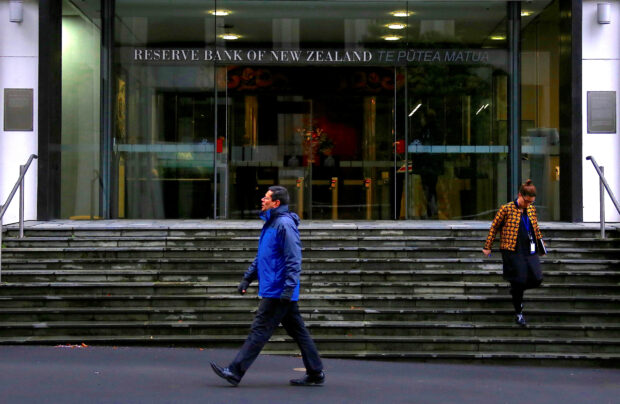
Pedestrians walk near the main entrance to the Reserve Bank of New Zealand located in central Wellington, New Zealand, July 3, 2017. Picture taken July 3, 2017. REUTERS/David Gray/file photo
WELLINGTON -New Zealand’s central bank held the cash rate steady at 5.5 percent on Wednesday and trimmed the forecast peak for rates, catching markets by surprise as policymakers said the risks to the inflation outlook have become more balanced.
The decision was in line with expectations from 28 economists in a Reuters poll with all but one forecasting the Reserve Bank of New Zealand (RBNZ) would leave the cash rate at a 15-year high for the fourth consecutive meeting.
Global central banks, led by the Federal Reserve, have recently pushed back against market expectations for an early start to rate cuts given persistent inflationary pressures.
READ: Market pushback on central banks’ rates view just got louder
The RBNZ’s statement was broadly in tune with global concerns about prices, reiterating that it needs to keep policy restrictive for a while.
However, the central bank’s rate forecast track signaled a slightly more dovish outlook than some traders had anticipated, triggering a selloff in the New Zealand dollar and a rally in bonds.
Core inflation
The RBNZ lowered its forecast cash rate peak to 5.6 percent from a previous projection of 5.7 percent – effectively reducing the risk of further tightening and aligns with a global consensus that the rate cycles have peaked.
“Core inflation and most measures of inflation expectations have declined, and the risks to the inflation outlook have become more balanced,” the RBNZ statement said.
READ: The mouse that roared: New Zealand and the world’s 2% inflation target
The market had priced in around a 23 percent chance of a hike this week. The probability of a move by May more than halved to just 20 percent, from 47 percent before the announcement, while two-year swap rates dived to 5.035 percent, from 5.195 percent and the kiwi dollar was down almost 0.8 percent at $0.6122, breaking support around $0.6152.
ASB chief economist Nick Tuffley said that the tone of the statement was not as hawkish as could have been, with the risks now seen as more balanced as opposed to the upward skew noted in November’s statement.
“We think over coming months the hurdle for an OCR move in either direction remains high,” he said.
Global policy
A front-runner in withdrawing pandemic-era stimulus among its peers, the RBNZ has battled to curb inflation, lifting rates by 525 basis points since October 2021 in the most aggressive tightening since the official cash rate was introduced in 1999.
The rate hikes have sharply slowed the economy with recent data showing that it was tracking below previous central bank expectations.
The RBNZ said that policy needs to remain restrictive for a while in order to bring inflation below its 1 percent to 3 percent target band, and noted a global impulse towards holding policy tighter for longer.
“A more general risk to global growth is that central banks may need to keep policy interest rates at restrictive levels for longer than currently reflected by financial market pricing, to ensure that inflation targets are met,” the statement said.
The central bank also flagged geopolitical risks and a slowdown in China’s economy as challenges for policy.
New Zealand’s annual inflation has come off in recent months and is currently running at 4.7 percent with expectations that it will return to its target band in the second half of this year.
“Members agreed they remain confident that monetary policy is restricting demand. A further decline in capacity pressure is expected, supporting a continued decline in inflation,” the central bank’s minutes, which accompanied the policy statement, said.